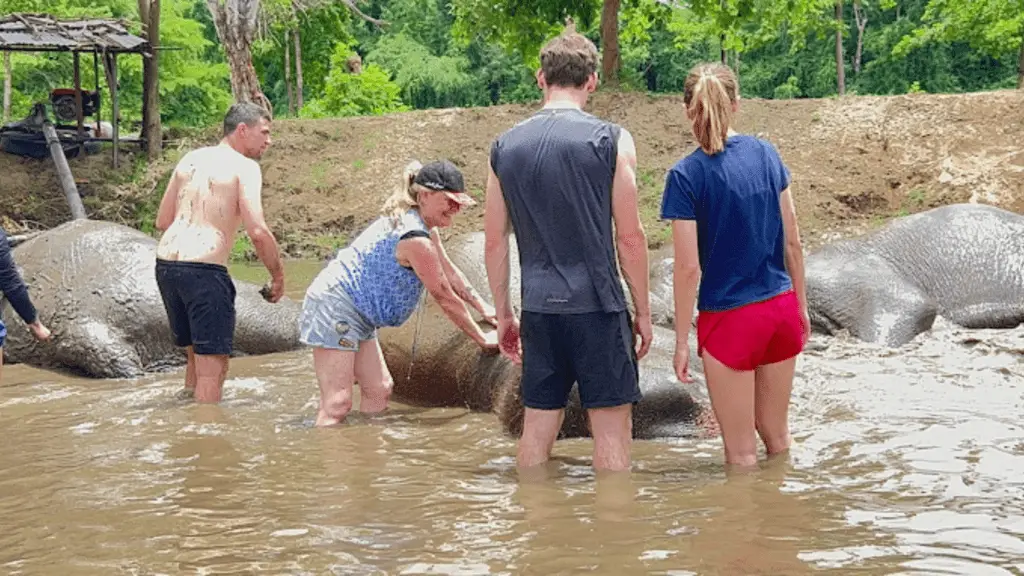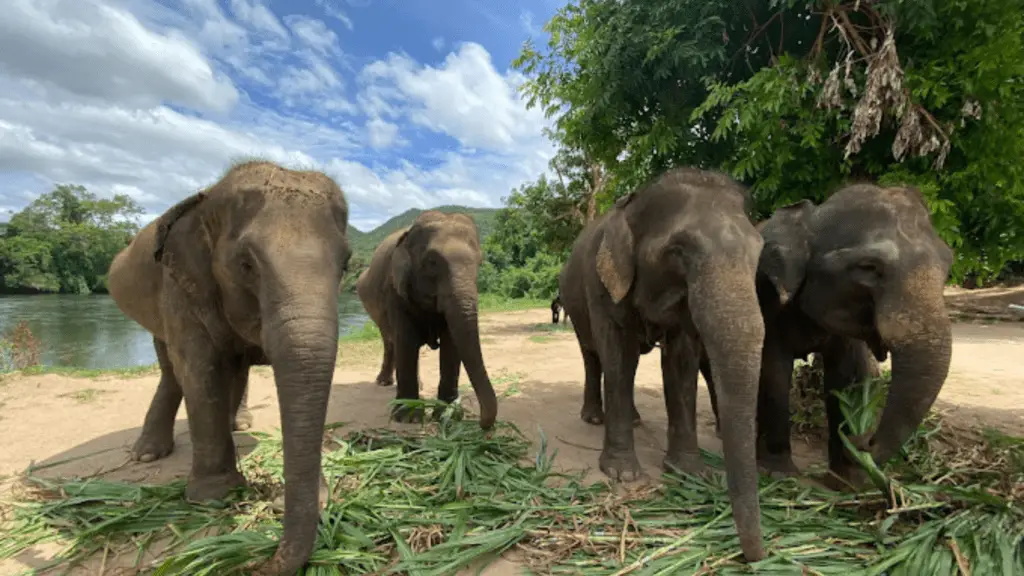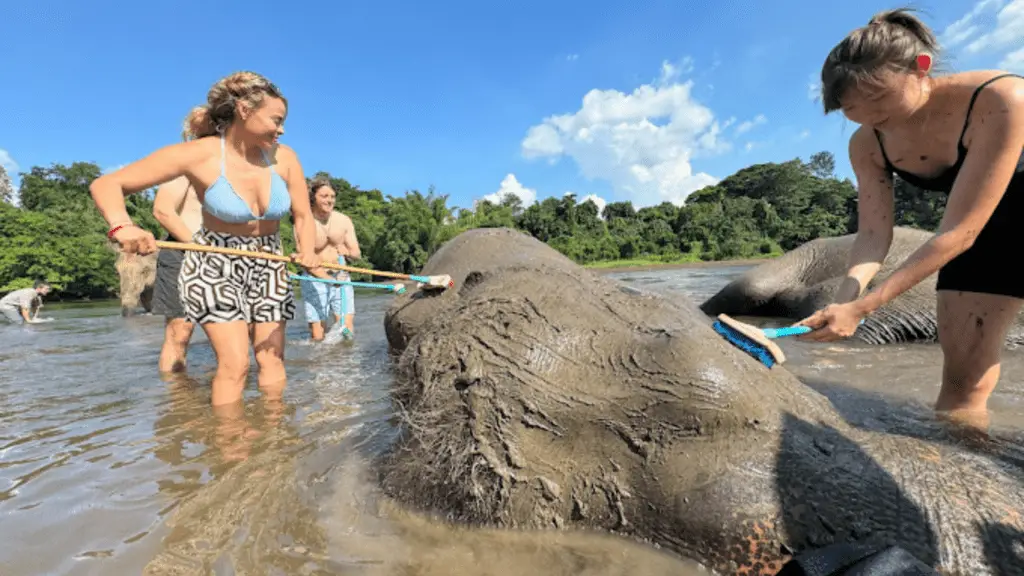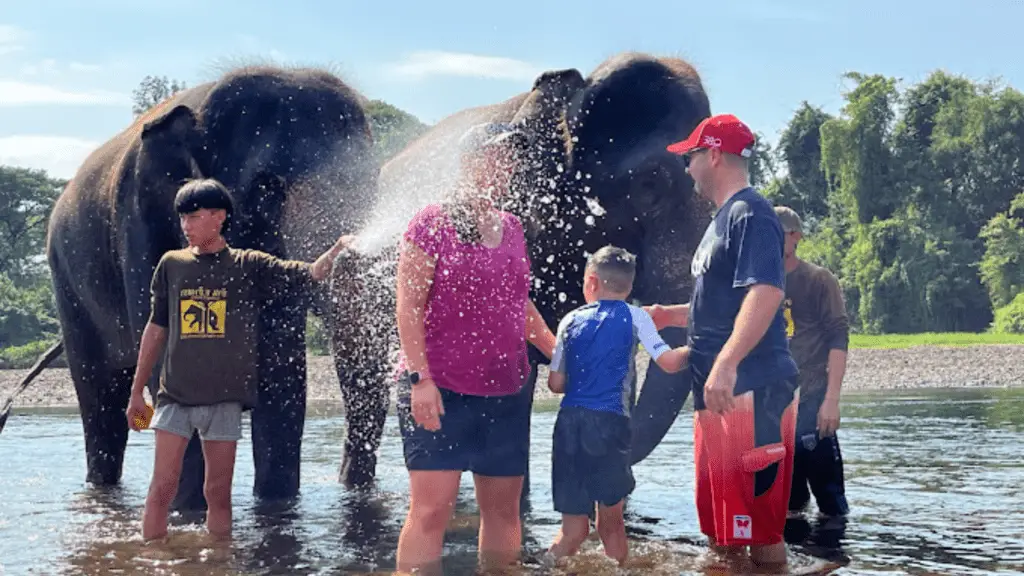Have you ever wondered what it’s like to spend a day among the majestic elephants in a sanctuary near Bangkok? Let me take you through a journey that is not only memorable but deeply touching and enlightening. Visiting an elephant sanctuary is a unique experience, offering a blend of adventure, education, and the profound joy of interacting with these gentle giants.
elephant sanctuary Bangkok tour
Morning Arrival – The Welcome
Your day begins early as the sanctuary awakens with the soft sounds of nature. Upon arrival, you’re greeted with a warm welcome from the staff who are not just caretakers of these magnificent creatures but also passionate about their welfare and conservation. You’re briefed on the sanctuary’s mission and the dos and don’ts during your visit.
Breakfast with a View
Enjoy a light breakfast in the viewing area where you can see elephants slowly starting their day. It’s a serene moment to sip your coffee and watch as these magnificent creatures amble in their natural habitat.
Educational Session
Post breakfast, a knowledgeable guide takes you through an educational session. Here, you learn about the history of elephants in Thailand, their behavior, and the threats they face in the wild. This session is eye-opening and sets the tone for the rest of the day.
The table includes options for full-day, half-day morning, and half-day afternoon tours, along with the respective prices for adults, children, and transportation arrangements where applicable.
Please note:
- Adult Price is for individuals aged 12 and over.
- Child Price is for children aged 4 to 11. Children under 3 are typically free of charge.
- Transportation Costs varies based on the tour type and whether it’s included in the tour price or charged separately.

Meeting the Elephants
Now, it’s time to meet the elephants! As you walk into their space, observe their natural behaviors. You get to see them bathing in mud, which is not just fun for them but also an essential skincare routine.
Lunchtime
After an eventful morning, you’re invited to a traditional Thai lunch. The meals are often prepared using ingredients grown in the sanctuary’s organic garden.
Afternoon Activities
Post-lunch, participate in the daily routine. This may include preparing food for the elephants and feeding them. Some sanctuaries also allow you to walk alongside the elephants as they roam around their habitat. This is a great opportunity to capture photographs and create lifelong memories.
Interactive Session
In the late afternoon, there’s usually an interactive session where you can learn more about elephant conservation efforts. This may include discussions about how the sanctuary operates and its role in the wider context of wildlife conservation.
Sunset and Reflection
As the day winds down, witness a beautiful sunset with the backdrop of elephants returning to their shelters. It’s a moment of reflection on the incredible experiences of the day.

Family-Friendly Visits to the Sanctuary
Visiting an elephant sanctuary can be an enriching and educational experience for families.
Before the Visit:
- Educational Prep: Start with educating your children about elephants and their conservation. Simple storybooks or documentaries can be a great way to spark their interest and prepare them for what they’ll see.
- Setting Expectations: Explain to kids that these are wild animals and should be treated with respect. Teach them about appropriate behavior, like speaking softly and moving slowly.
Choosing the Right Sanctuary:
- Family-Friendly Facilities: Look for sanctuaries that are known for being family-friendly. These will often have educational programs tailored for children.
- Check Reviews: Read reviews from other families to ensure the sanctuary is suitable for children.
During the Visit:
- Safety First: Always follow the sanctuary’s rules and stay with your guide. Never allow children to approach the elephants without supervision.
- Interactive Learning: Encourage your kids to ask questions. Many sanctuaries have knowledgeable guides who can provide insightful answers.
- Observation Skills: Teach children to observe elephant behaviors and explain what they might mean, turning the visit into a live learning session.

Participating in Activities
- Age-Appropriate Activities: Ensure that the activities are suitable for your children’s age. Some sanctuaries offer activities like feeding the elephants, which can be a thrilling experience for kids.
- Hands-On Learning: Activities like preparing elephant food or learning about elephant care can be both fun and educational.
Post-Visit Activities:
- Discussion and Reflection: After the visit, talk with your kids about their experiences. What did they learn? What did they find most interesting?
- Creative Expression: Encourage them to draw pictures of their experience or write a story about the day to reinforce their learning.

What to Pack for Your Elephant Sanctuary Tour
Preparing for an elephant sanctuary tour in Bangkok requires thoughtful planning, especially considering the climate and terrain. Packing the right items will enhance your comfort and ensure a more enjoyable experience. Here’s a practical guide on what to wear and bring for your visit.
Clothing Essentials:
- Lightweight, Breathable Fabrics: Choose light-colored, breathable clothing. Bangkok’s climate is typically warm and humid.
- Long Sleeves and Pants: Protect your skin from the sun and mosquitoes with long-sleeved shirts and pants. Light materials are recommended.
- Comfortable Footwear: Wear sturdy, closed-toe shoes suitable for walking on uneven terrain. Avoid flip-flops or sandals.
- Hat and Sunglasses: Bring a hat with a brim for sun protection and sunglasses to shield your eyes.
Packing Must-Haves:
- Sunscreen: Essential for protection against the strong Thai sun. Opt for a water-resistant, high-SPF sunscreen.
- Insect Repellent: To keep mosquitoes and other insects at bay, especially important in rural or forested areas.
- Hydration: Bring a refillable water bottle. Staying hydrated is crucial in the heat.
An Unforgettable Experience
For animal lovers and conservation enthusiasts, volunteering at an elephant sanctuary offers an immersive and impactful experience. It’s an opportunity to contribute to the well-being of elephants and learn about conservation efforts firsthand. Here, I’ll share insights and stories from those who have volunteered, providing a glimpse into what makes this experience so unique and fulfilling.
The Volunteer Experience
Volunteers at an elephant sanctuary engage in a variety of tasks, each contributing to the daily operations and care of the elephants. Activities include preparing food for the elephants, assisting with feeding, participating in health checks, and helping with habitat maintenance.

A Day in the Life of a Volunteer
Your day might start early with the preparation of the elephants’ meals – cutting up fruits and vegetables. Then, you could be involved in feeding the elephants, an intimate experience where you witness their gentle nature up close. Part of your day may also include cleaning the elephants’ living areas and ensuring their environment is safe and comfortable.
Learning and Growth:
Volunteers often describe their time at the sanctuary as an educational journey. You learn about elephant behavior, their needs, and the challenges they face in the wild. This knowledge is invaluable and often leads to a deeper understanding and commitment to wildlife conservation.
Community and Connection
Living and working alongside other volunteers from around the world, you become part of a community. Shared experiences, like observing the elephants in their natural habitat or having discussions with the sanctuary staff, create strong bonds and lasting friendships.
Making the Most of Your Volunteering Experience:
- Embrace Learning: As a volunteer, every task is an opportunity to learn. Engage with the caretakers, ask questions, and absorb as much information as you can about the elephants and their care.
- Document Your Journey: Keep a journal or a blog. Documenting your experiences not only serves as a personal keepsake but can also inspire others to support or volunteer for conservation efforts.
- Stay Open-Minded: Working in a new environment, often in a different culture, requires flexibility and open-mindedness. Embrace the differences and learn from them.
- Contribute Beyond Physical Labor: While the daily care of elephants is a significant part of the work, there are other ways to contribute. If you have skills in areas like education, social media, photography, or fundraising, offer them to the sanctuary.
- Take Care of Yourself: Working in a sanctuary can be physically and emotionally taxing. Practice self-care, stay hydrated, and rest when needed.
- Build Relationships: Get to know the people around you. The staff, fellow volunteers, and even the local community are integral parts of your experience. These relationships can be deeply rewarding and offer insights into local life and conservation efforts.
- Reflect and Share: After your volunteer stint, take time to reflect on your experiences. Share your stories with friends, family, and your community. Raising awareness is a crucial part of conservation work.
Benefits of Volunteering
Volunteering at an elephant sanctuary is not just about the work done on the ground. It’s an enriching experience that can change perspectives. Volunteers often leave with a greater sense of global citizenship, a deeper understanding of conservation issues, and the satisfaction of having made a tangible contribution to the welfare of elephants.
A Lasting Impact
find that their experience at the elephant sanctuary ignites a passion for wildlife and conservation that lasts long after they return home. Whether it’s through continued advocacy, support for conservation organizations, or a change in lifestyle choices, the impact of this experience can extend far beyond the time spent at the sanctuary.
Conclusion
As you leave the sanctuary, you’re not just carrying back pictures and memories, but also a deeper understanding and connection with these majestic animals. A visit to an elephant sanctuary is more than just a tourist activity; it’s a step towards supporting ethical wildlife tourism and conservation efforts.


